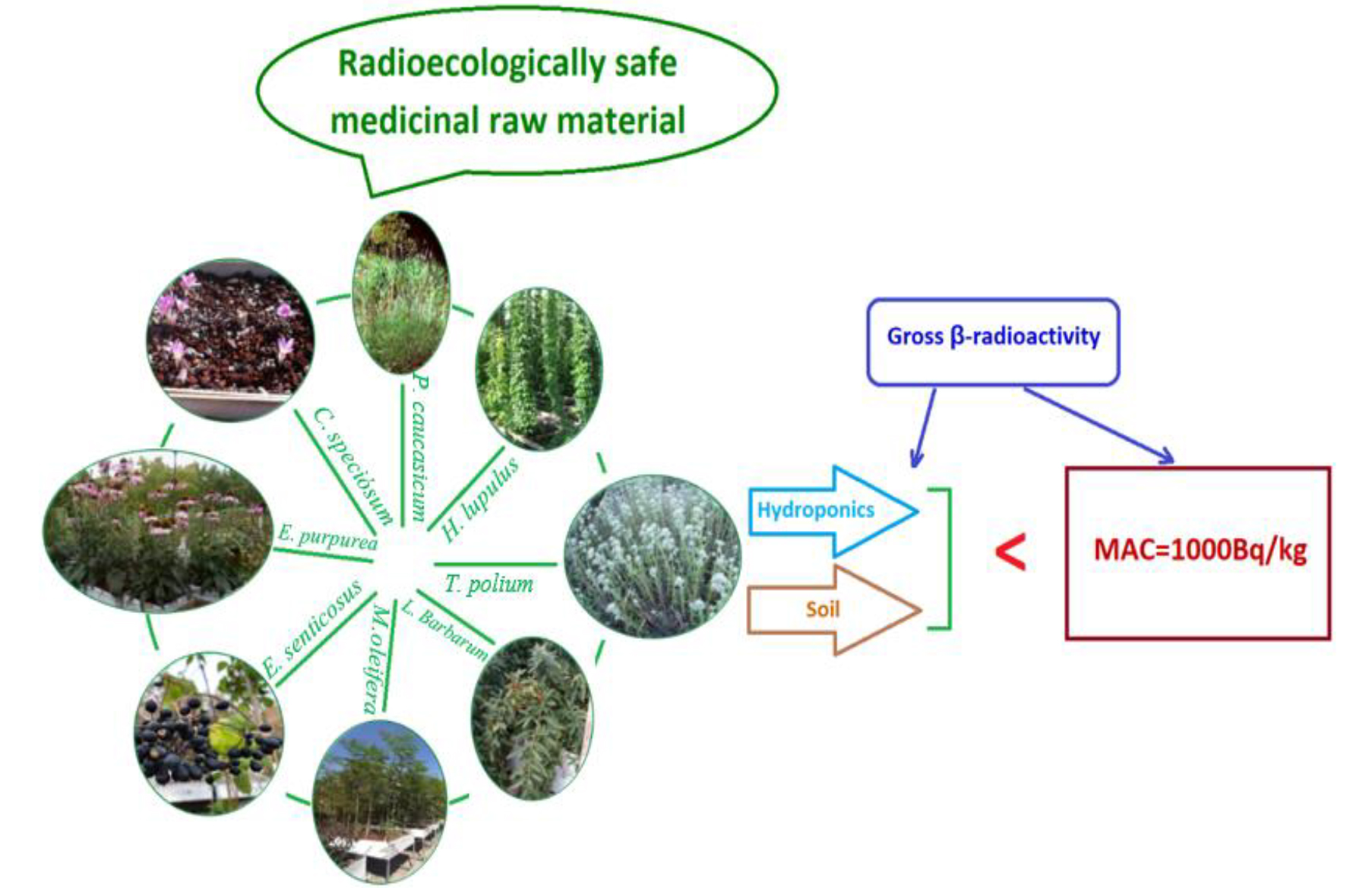The study of gross beta-radioactivity of some medicinal plants in conditions of outdoor hydroponics and soil culture in Ararat Valley
DOI :
https://doi.org/10.31989/bchd.v6i10.1174Résumé
Background: Technogenic and natural radionuclides (RN) along the biogeochemical chains of agrocenoses may enter the human body through irrigation water- soil- plants- agricultural animals, likewise in hydroponic systems through nutrient solution substrate plants, leading to the development of dangerous diseases. Thus, control of herbal raw material’s gross β-radioactivity and obtaining radioactively safe medicinal raw material are priority issues. Since 1996 we have carried out radio monitoring research in the Ararat valley (where the Armenian Nuclear Power Plant (ANPP) is located) in water, soil, and plant systems in zones of the ANPP with a radius of 2-15, 20 (the territory of Ashtarak city), 30 km (Yerevan, territory of Institute of Hydroponics Problems) (IHP), as well as Dilijan Forest Experimental Station (DFES) (the zone of ANPP with 90 km radius). Studies have shown that in natural waters (artesian water, Hrazdan, Qasakh, Metsamor rivers), soils and in various crops (vegetables, fruit of trees, etc.) of Ararat Valley the content of technogenic RN 90Sr (T1/2=28.6 years) and 137Cs (T1/2=30.1 years) did not exceed maximum allowable concentrations (for drinking water MAC 90Sr=5.0 Bq/L, MAC 137Cs=11.0 Bq/L; for vegetables and fruits MAC 90Sr=50 Bq/L, MAC 137Cs=130 Bq/L). Based on these studies, a complex of practical recommendations in this region will give the opportunity of obtaining ecologically pure agricultural products.
Objective: Considering that the accumulation of RN in medicinal plants poses a particularly great threat to obtaining radioecologically safe medicinal raw materials, during 2017-2022 we studied the specificities of gross β-radioactivity and accumulation of controlled technogenic RN (90Sr and 137Cs) in medicinal plants under hydroponics and soil conditions in the Ararat valley (the zone of ANPP with 30 km radius). This has a specific practical significance, as it will enable to obtain the most radio-ecologically safe plant material.
Methods: Gross β-radioactivity and content of 90Sr and 137Cs of samples (artesian water (irrigation water), nutrient solution, soil layers with depth of 0 - 30 cm and number of medicinal plants) in it were defined with radio-chemical extraction methods through the radiometer UMF-1500 (made in Russia) with low background. 90Sr was determined by the oxalate method with 90Y. RN were determined in dry sediments of waters, nutrient solution, the ash of plants, and soils. The following chemical reagents were used for the analysis: C2H2O4, HNO3, HCl, CH3COOH, CsCl, Y2O3, YCl3, K2SO4, KI, Sr(NO3)2, CeCl3, Ni(NO3)2, SbCl3, K4[Fe(CN)6] 3H2O and others.
Results: The radio-chemical studies showed that the gross β-radioactivity of herbs in hydroponics fluctuated between 250 – 740 Bq/kg, and in soil: 140 – 690 Bq/kg. Thus, the medicinal raw material from the medicinal plants cultivated in outdoor hydroponics and soil, is radioecologically safe, since its gross β-radioactivity does not exceed the threshold of 1.0 Bq/g. Medicinal plants grown in hydroponics and soil, with a slight deviation, show the same gross β-radioactivity decreasing pattern as follows: Peucedanum caucasicum (M.Bieb.) K. Koch. > Lycium barbarum > Eleutherococcus senticosus (Rupr. & Maxim.) > Teucrium polium = Humulus lupulus, variety “Crystal” > Echinacea purpurea (L.) Moench > Humulus lupulus, variety “Chinook” > Humulus lupulus, variety “Newport” > Colchicum speciosum Stev. > Moringa oleifera Lam. Our studies have shown that the proportion of 90Sr and 137Cs together in gross β-radioactivity in different medicinal plants fluctuated between 1.0-7.4 % of dry mass in hydroponics and 1.7-10.1 % of dry mass in soil. In the gross β-radioactivity of medicinal plants the share of 90Sr and 137Cs in hydroponics was 1.2-3.0 and 1.3-2.3 times lower than that of soil plants.
Conclusion: In artesian waters, gray soils and different medicinal plants grown in hydroponic settings and soil of Ararat Valley the content of controlled technogenic RN (90Sr and 137Cs) did not exceed MAC. Both medicinal raw materials grown in hydroponic settings and soil in Ararat Valley are radioecologically safe.

Keywords: technogenic radionuclides, nutrient solution, herbal raw materials, 90Sr, 137Cs
Téléchargements
Publié
Numéro
Rubrique
Licence
© FFC/Bioactive Compounds in Health and Disease 2023

Cette œuvre est sous licence Creative Commons Attribution - Pas d'Utilisation Commerciale 4.0 International.
Any manuscripts or substantial parts of it, submitted to the journal must not be under consideration by or previously published in any other journal or citable form. Authors are required to ensure that no material submitted as part of a manuscript infringes existing copyrights or the rights of a third party. In submitting one's article in any form, the author has assigned the FFC publishing rights and has agreed to an automatic transfer of the copyright to the publisher. This is so that the FFC may create print option journals, for example, at the FFC’s discretion. If the author wishes to distribute their works by means outside of the FFC, for example within their community, they will have to place a request.
Correspondence concerning articles published in Functional Foods in Health and Disease is encouraged. While derivative works (adaptations, extensions on the current work, etc.) are allowed, distribution of the modified material is not allowed without permission from the FFC.